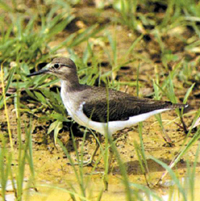Sandpiper
Sandpiper (chapakhi) lightly built with relatively long legs, and long and slender bills; camouflaged waders of the family Scolopacidae, order Ciconiiformes. The tip of the bill is extremely sensitive and used to probe the sand and mud for food. Their plumage is dull, usually streaked brown or grey above and buff with streaks or spots below. Most bills seem designed to exploit part of the range of organisms in the mud and sand of the birds' winter quarters. On rich mudflats large flocks can feed together, and may move and maneuver in close rapid flight. The breeding grounds, ie the Northern Hemisphere, may not seem ideal for the adults' bill-shapes, but they have abundant insects that soon become food for the short-billed young. The open areas used by many for nesting encourage aerial displays, which are accompanied by the musical piping calls typical of these birds. The eggs, usually three or four, are often laid in bare scrapes (no nest material is carried). Three species of sandpipers do not nest on ground. The Solitary Sandpiper of the New World, and the Green and Wood Sandpipers of the Old World usually use abandoned nests of other birds, and nest in trees. Twelve species of sandpipers occur worldwide; in Bangladesh there are eight, all are migratory.

Sandpipers of Bangladesh are: Cha-pakhi (Common Sandpiper, Actitis hypoleucos): Greyish olive-brown above, white below with pale dusky breast and a few dark streaks on foreneck. In flight the brown rump and tail distinguish it from the Spotted Sandpiper. A prominent wing bar is usually present. Sexes alike; Curlew Sandpiper (Calidris ferruginea): Larger size, longer legs; downcurved but slender bill are diagnostic. Greyish brown above with a fine dark mottling; breast white with brown below. In flight white upper tail-coverts are visible. In summer the plumage become chestnut; Spoon-billed Sandpiper (Calidris pygmeus): It has a unique spatula-shaped bill. In winter the bird is largely white, with greyish brown upperparts (including crown). Rump and upper tail-coverts dark brown in the middle, white at sides.
In summer plumage blackish above; foreneck and breast spotted with dark brown; rest white; Broad-billed Sandpiper (Limicola falcinellus): Bill slightly downcurved like Curlew Sandpiper. Dark greyish brown above, white below, somewhat streaked on breast. Rump, upper tail-coverts and middle retrices brown.
Prominent white supercilium and black wing shoulder-patch distinctive; Wood Sandpiper (Tringa glareola): looks like a snipe; brown above, indistinctly spotted with white, lower back and rump white, breast pale brownish, whitish stripe above eye from bill to nape. Summer plumage is brighter, with spots more defined. In flight, the white rump and barred brown-and-white tail diagnostic. Sexes alike; Green Sandpiper (Tringa ochropus): In winter head and neck ashy brown; rest of upper parts dark brown glossed with bronze-green. Rump and tail white; tail barred with blackish. Below white, finely streaked with brown on throat, breast and flanks. Sexes alike. In summer crown and hindneck with white edges to the feathers. Brown streaks appear on foreneck and upper breast; Jalar Cha-pakhi (Marsh Sandpiper, Tringa stagnatilis): There is no wing bar. In winter, forehead, supercilium, sides of head, lower back and rump pure white; otherwise greyish brown above. Below white, sides of breast marked brown; bill black, almost straight; slender green legs. Sexes alike. In summer grey above with dark angular spots on back. Below white; foreneck and upper breast brown spotted; Avocet-sandpiper (Xenus cinereus): Bill long, slender and upcurved; legs short and orange yellow. Pale ashy brown rump and white trailing edge of dark wings conspicuous in flight. Winter plumage greyish brown above with white forehead and supercilium white below. Sexes alike. In summer bold black streaks forming a V-shaped mark on back; sides of head and neck and breast with distinct brown striations. [Md Anwarul Islam]
